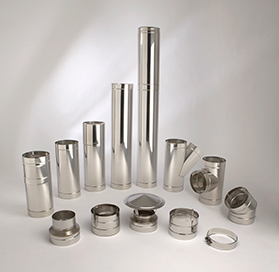The vast majority of older properties already have a chimney therefore installing a wood-burning stove is made that much easier. The situation is a little different for more modern houses where there is no chimney, yet the occupants would like to install a wood-burning stove. At first glance you may automatically assume it is not possible, but it is, there are ways and means of installing a wood-burning stove in a property without a traditional chimney.
Installing an insulated steel flue
An insulated steel flue is also referred to as a twin wall flue which is to all intents and purposes a steel chimney. This is added to your property and where possible the most common installation process involves the flue passing through the nearest outside wall and up the outside of the building. This ensures that the gases are removed from the room as soon as possible and directed up into the atmosphere. Ideally there would be 4.5m of straight flue pipe (available in black as well as stainless steel) up the side of the building for the steel chimney to work at its best.

There will be situations where the positioning of the stove may not accommodate the sidewall option and therefore the insulated steel flue will need to run up inside the building and out through the roof. The first preference would be to direct the insulated steel flue through the nearest outer wall and up the side of the building because the second option can cause some inconvenience as it goes up through the rooms. However, it is certainly not dangerous because of the way the insulated steel flue is manufactured.
What is an insulated steel flue?
Commonly referred to as a steel chimney, or twin wall flue, this is simply two different sized flue pipes one inside the other. There is at least an inch of insulation between the pipes and the inner pipe is where the stove gases travel through on their way up to the top of the flue. The use of two pipes ensures that the inner flue is totally separate from the outer flue with the 1 inch of insulation making sure that the heat from the inside steel flue does not impact the outer casing. This ensures that nobody is in danger of burning themselves and the structure is perfectly safe.
This set up also allows the high temperature within the inner flue to be maintained because if flue gases were to cool they would condense and often leave a sticky tar like material. This can cause blockages and in a worst-case scenario a chimney fire but with the two flue structure a high temperature is maintained as the gases pass through.
Is this expensive?

Each property will be different and the overall cost will depend upon the structure of the property. The more flue pipe required the greater the expense and the more difficult the installation the longer this will take and will obviously impact the overall cost. When installing a stove, and an insulated steel flue, it is vital that only HETAS approved installers are used. These installs are fully trained with regards to the installation of stoves as well as insulated steel flues. There are also regulations which need to be met when installing such structures in order to protect the safety of the residents.
If you require any additional advice regarding the installation of a stove and an insulated steel flue please feel free to contact us and we can discuss your particular situation in more detail.

